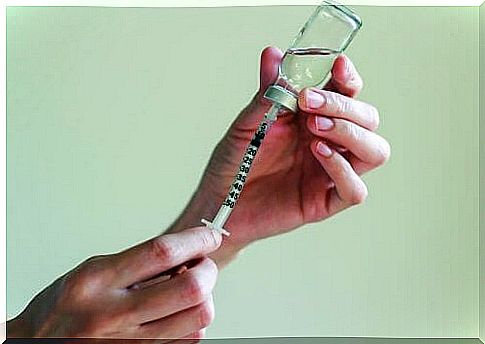Thiopental: Administration And Contraindications

Thiopental is a drug used as a general anesthetic. In particular, this substance belongs to the group of barbiturates, used as sedatives and analgesics, due to its depressant action on the central nervous system. We can also find it under the name sodium thiopentate as it is a drug derived from thiobarbituric acid.
Nowadays it is little used, as there are other drugs that produce less side effects, in smaller doses. Patients commented that, upon waking up from anesthesia, they felt sluggish and slightly disoriented; in fact, almost everyone said it was similar to the hangover state after drinking alcohol.

In any case, it is a very short-acting medicine that has been tried to induce the patient into a state of hypnosis. What, in the end, was denied, as it was scientifically demonstrated that it was only an anesthetic that lasted a few minutes.
What is the mechanism of action of thiopental?
Thiopental, like all barbiturates, binds to GABA receptors . Its mechanism of action is the same as that of other relaxants such as benzodiazepines (although the receptor subtype is different).
When the substance binds to the receptor, they form a binding complex, which modulates the transmission of information towards the central nervous system.
As a final result of the interaction, the sedative and anesthetic effect occurs. If there are seizures, it will also block them by modulating the neurotransmitter GABA, so it is also used as an anticonvulsant.
When sedating the patient, the person enters a state of tranquility, which reduces brain metabolism. As the nutritional needs are very low, the blood supply also decreases. For this reason, it serves to reduce blood flow and therefore intracranial pressure.
What is thiopental used for?
This is especially useful in emergency situations. For example, cases where the patient is not ventilating properly, and has suffered some type of trauma to the mouth, so that there is blood, foreign bodies that prevent the visualization of the path to intubation. In this case, inhalation anesthesia is usually chosen.
It can also be used as general anesthesia for short interventions. Although, as we mentioned earlier, it has gradually been left out of use, and the use of other types of medication is generally preferred. Mainly because it is anesthetic and sedative, but not analgesic. That is, it does not reduce pain. It just relaxes the patient.
There are very specific situations where it may be an option to consider. For example, when patients who have suffered head trauma have refractory cranial hypertension, it can be used to prepare for neurosurgery.
In the case of psychiatric patients who have seizures that do not respond to other treatment, it can also be used.
What are the contraindications for thiopental?
There are several c ontraindicações thiopental , which can be summarized in the following points:
- Hypersensitivity to barbiturates: this means that, with a small dose, the effect on the patient is very intense and long-lasting. As it is an anesthetic, it can cause respiratory depression.
- Mix it with other central nervous system depressants: especially alcohol. Since they work very similarly, which enhances the effect.
- Pregnancy and breast-feeding: Thiopental passes to the fetus and therefore causes depression of the baby’s nervous system.
- Work that requires handling dangerous substances or driving vehicles: its sedative effect reduces the ability to concentrate.
What are the routes of administration of thiopental?
Thiopental is always used intravenously, with the exception of inhalation anesthesia for intubation. There are variations in dosage, but it is normal to use injectables 2-4 mg/kg. This dose is variable, and each person has a different sensitivity, so you should start with the smallest amount, and increase little by little
The maximum effect is reached one minute after administration and, as mentioned above, lasts for a few minutes if it is not stabilized with a maintenance dose.









